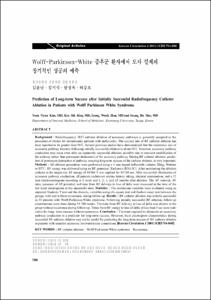KUMEL Repository
1. Journal Papers (연구논문)
1. School of Medicine (의과대학)
Dept. of Internal Medicine (내과학)
Wolff-Parkinson-White 증후군 환자에서 도자 절제의 장기적인 성공의 예측
- Alternative Author(s)
- Kim, Yoon Nyun; Kim, Kee Sik; Han, Seong Wook; Hur, Seung Ho
- Journal Title
- 순환기
- ISSN
- 1225-164X
- Issued Date
- 2001
- Abstract
- Background:Radiofrequency (RF) catheter ablation of accessory pathways is generally accepted as the
procedure of choice for symptomatic patients with tachycardia. The success rate of RF catheter ablation has
been reported to be greater then 90%. Several previous studies have demonstrated that the recurrence rate of
accessory pathway function following initially successful ablation is about 10%. However, accessory pathway
conduction may recur even after an apparently successful ablation, possibly due to transient modification of
the pathway rather than permanent destruction of the accessory pathway. During RF catheter ablation, prediction
of permanent destruction of pathway, ensuring long-term success of the catheter ablation, is very important.
Methods:All ablation procedures were performed using a 4 mm tipped deflectable catheter (Diag, Webster
or EPT). RF energy was delivered using an RF generater (Radionics RFG-3C). After positioning the ablation
catheter at the target site, RF energy of 40-60 V was applied for 30-60 sec. After successful elimination of
accessory pathway conduction, all patients underwent routine history taking, physical examination, and a 12
lead electrocardiogram recording at 1 week and 1, 2, 3, and 12 months after ablation. The AV interval, AV
ratio, presence of AP potential, and time from RF delivery to loss of delta were measured at the time of the
last local electrograms at the successful sites. Statistics:The continuous variables were evaluated using an
unpaired Students T test and the discrete, variables using chi-square test and fischers exact test between the
groups, with and without recurrence, during follow-up. Results:RF catheter ablation was initially successful
in 35 patients with Wolff-Parkinson-White syndrome. Following initially successful RF ablation, follow-up
examinations were done during 55±40 weeks. The time from RF delivery to loss of delta was shorter in the
group without recurrence during follow-up. Times from RF energy to loss of delta of less than 5 sec were indicative
for long- term success without recurrence. Conclusion:The time required to eliminate an accessory
pathway conduction is a predictor for long term success. However, local electrogram characteristics during
successful RF catheter ablation may not be useful for predicting the long term success of RF catheter ablation
in patients with manifest accessory atrioventricular connections.(Korean Circulation J 2001;31(8):794-800)
- Alternative Title
- Prediction of Long-term Success after Initially Successful Radiofrequency Catheter
Ablation in Patients with Wolff Parkinson White Syndrome
- Department
- Dept. of Internal Medicine (내과학)
- Publisher
- School of Medicine
- Citation
- 김윤년 et al. (2001). Wolff-Parkinson-White 증후군 환자에서 도자 절제의
장기적인 성공의 예측. 순환기, 31(8), 794–800. doi: 10.4070/kcj.2001.31.8.794
- Type
- Article
- ISSN
- 1225-164X
- Appears in Collections:
- 1. School of Medicine (의과대학) > Dept. of Internal Medicine (내과학)
- 파일 목록
-
-
Download
 oak-bbb-4633.pdf
기타 데이터 / 280.67 kB / Adobe PDF
oak-bbb-4633.pdf
기타 데이터 / 280.67 kB / Adobe PDF
-
Items in Repository are protected by copyright, with all rights reserved, unless otherwise indicated.